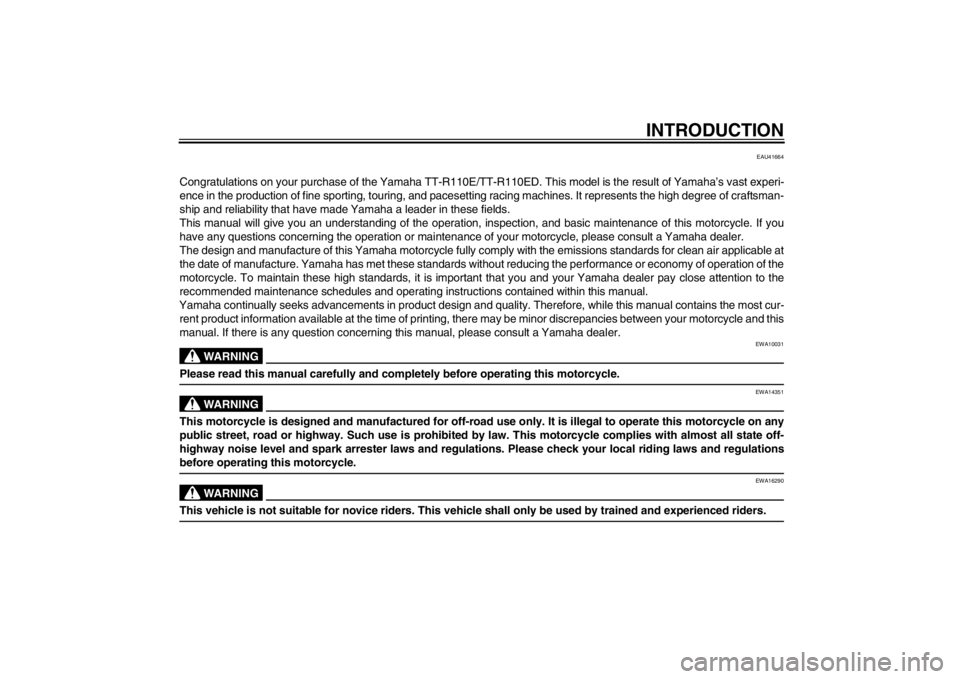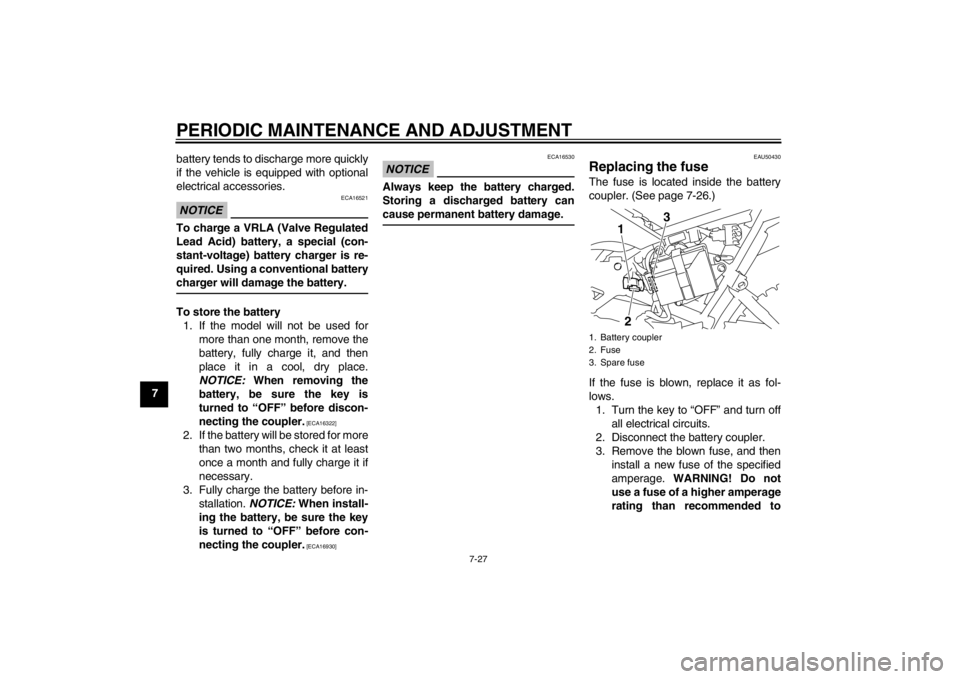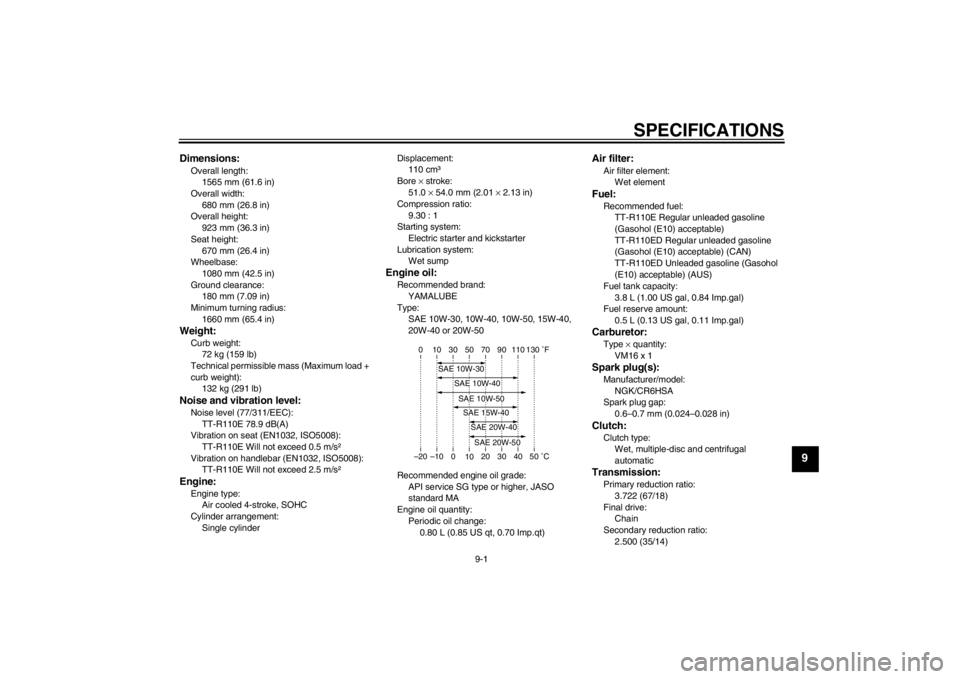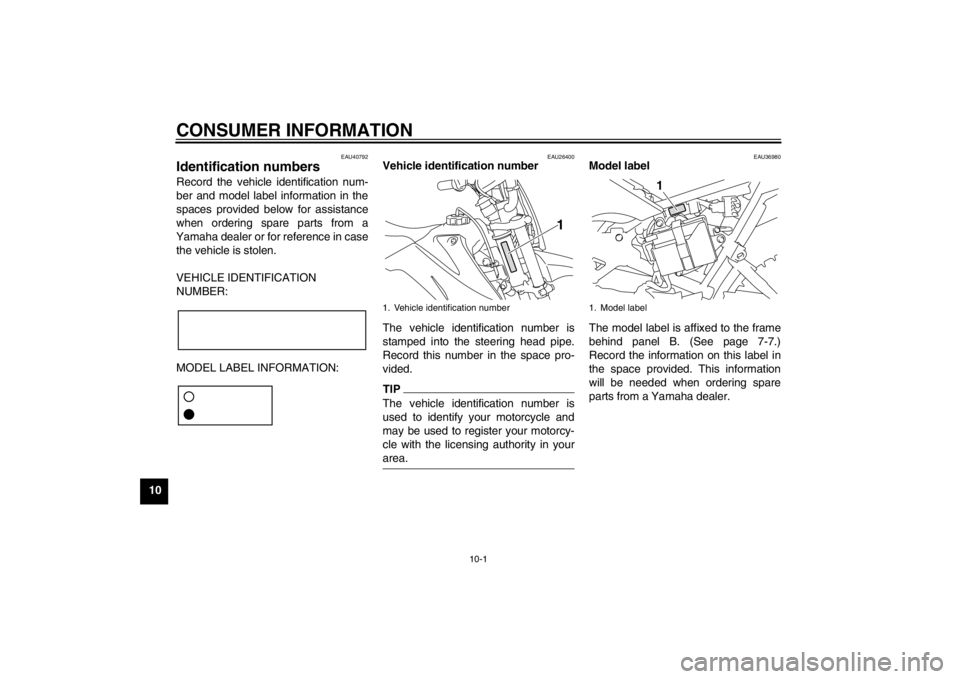ECO mode YAMAHA TTR110 2013 Owners Manual
[x] Cancel search | Manufacturer: YAMAHA, Model Year: 2013, Model line: TTR110, Model: YAMAHA TTR110 2013Pages: 88, PDF Size: 2.02 MB
Page 5 of 88

INTRODUCTION
EAU41664
Congratulations on your purchase of the Yamaha TT-R110E/TT-R110ED. This model is the result of Yamaha’s vast experi-
ence in the production of fine sporting, touring, and pacesetting racing machines. It represents the high degree of craftsman-
ship and reliability that have made Yamaha a leader in these fields.
This manual will give you an understanding of the operation, inspection, and basic maintenance of this motorcycle. If you
have any questions concerning the operation or maintenance of your motorcycle, please consult a Yamaha dealer.
The design and manufacture of this Yamaha motorcycle fully comply with the emissions standards for clean air applicable at
the date of manufacture. Yamaha has met these standards without reducing the performance or economy of operation of the
motorcycle. To maintain these high standards, it is important that you and your Yamaha dealer pay close attention to the
recommended maintenance schedules and operating instructions contained within this manual.
Yamaha continually seeks advancements in product design and quality. Therefore, while this manual contains the most cur- rent product information available at the time of printing, there may be minor discrepancies between your motorcycle and this
manual. If there is any question concerning this manual, please consult a Yamaha dealer.
WARNING
EWA10031
Please read this manual carefully and completely before operating this motorcycle.
WARNING
EWA14351
This motorcycle is designed and manufactured for off-road use only. It is illegal to operate this motorcycle on any
public street, road or highway. Such use is prohibited by law. This motorcycle complies with almost all state off-
highway noise level and spark arrester laws and regulations. Please check your local riding laws and regulations
before operating this motorcycle.
WARNING
EWA16290
This vehicle is not suitable for novice riders. This vehicle shall only be used by trained and experienced riders.
U5B685E0.book Page 1 Tuesday, July 10, 2012 5:06 PM
Page 22 of 88

SAFETY INFORMATION
2-3
2
●
Do not run engine indoors. Even if
you try to ventilate engine exhaust
with fans or open windows and
doors, carbon monoxide can rap-
idly reach dangerous levels.
●
Do not run engine in poorly venti-
lated or partially enclosed areas
such as barns, garages, or car-
ports.
●
Do not run engine outdoors where
engine exhaust can be drawn into
a building through openings such
as windows and doors.
Loading
Adding accessories to your motorcycle
can adversely affect stability and han-
dling if the weight distribution of the mo-
torcycle is changed. To avoid the
possibility of an accident, use extreme
caution when adding accessories to
your motorcycle. Use extra care when
riding a motorcycle that has added ac-
cessories. Here are some general
guidelines to follow if adding accesso-
ries to your motorcycle:
Operation of an overloaded vehicle
could cause an accident.
●
The weight of the operator must
not exceed 60.0 kg (132 lb).
●
Accessory weight should be kept
as low and close to the motorcycle
as possible. Securely pack your
heaviest items as close to the cen-
ter of the vehicle as possible and
make sure to distribute the weight
as evenly as possible on both
sides of the motorcycle to mini-
mize imbalance or instability.
●
Shifting weights can create a sud-
den imbalance. Make sure that ac-
cessories are securely attached to
the motorcycle before riding.
Check accessory mounts fre-
quently. Properly adjust the suspension for your load (suspension-ad-
justable models only), and
check the condition and pres-
sure of your tires.
Never attach any large or heavy items to the handlebar, front
fork, or front fender. Genuine Yamaha Accessories
Choosing accessories for your vehicle
is an important decision. Genuine
Yamaha accessories, which are avail- able only from a Yamaha dealer, have
been designed, tested, and approved
by Yamaha for use on your vehicle.
Many companies with no connection to
Yamaha manufacture parts and acces- sories or offer other modifications for
Yamaha vehicles. Yamaha is not in a position to test the products that these
aftermarket companies produce.
Therefore, Yamaha can neither en-
dorse nor recommend the use of ac-
cessories not sold by Yamaha or
modifications not specifically recom-
mended by Yamaha, even if sold and
installed by a Yamaha dealer.
Aftermarket Parts, Accessories, and
Modifications
While you may find aftermarket prod-
ucts similar in design and quality to
genuine Yamaha accessories, recog-
nize that some aftermarket accessories
or modifications are not suitable be-
cause of potential safety hazards to you
or others. Installing aftermarket prod-
U5B685E0.book Page 3 Tuesday, July 10, 2012 5:06 PM
Page 23 of 88

SAFETY INFORMATION
2-4
2
ucts or having other modifications per-
formed to your vehicle that change any
of the vehicle’s design or operation
characteristics can put you and others
at greater risk of serious injury or death.
You are responsible for injuries related
to changes in the vehicle.
Keep the following guidelines in mind,
as well as those provided under “Load-
ing” when mounting accessories.
●
Never install accessories that
would impair the performance of
your motorcycle. Carefully inspect
the accessory before using it to
make sure that it does not in any
way reduce ground clearance or
cornering clearance, limit suspen-
sion travel, steering travel or con-
trol operation.
Accessories fitted to the handle- bar or the front fork area can
create instability due to improper
weight distribution. If accesso-
ries are added to the handlebar
or front fork area, they must be
as lightweight as possible and
should be kept to a minimum. Bulky or large accessories may
seriously affect the stability of
the motorcycle. Wind may at-
tempt to lift the motorcycle, or
the motorcycle may become un-
stable in cross winds.
Certain accessories can dis- place the operator from his or
her normal riding position. This
improper position limits the free-
dom of movement of the opera-
tor and may limit control ability,
therefore, such accessories are
not recommended.
●
Use caution when adding electri-
cal accessories. If electrical acces-
sories exceed the capacity of the
motorcycle’s electrical system, an
electric failure could result, which
could cause a dangerous loss of
lights or engine power.
Aftermarket Tires and Rims
The tires and rims that came with your
motorcycle were designed to match the
performance capabilities and to provide
the best combination of handling, brak-
ing, and comfort. Other tires, rims, siz-
es, and combinations may not be appropriate. Refer to page 7-15 for tire
specifications and more information on
replacing your tires.
Transporting the Motorcycle
Be sure to observe following instruc-
tions before transporting the motorcy-
cle in another vehicle.
●
Remove all loose items from the
motorcycle.
●
Check that the fuel cock (if
equipped) is in the “OFF” position
and that there are no fuel leaks.
●
Point the front wheel straight
ahead on the trailer or in the truck
bed, and choke it in a rail to pre-
vent movement.
●
Shift the transmission in gear (for
models with a manual transmis-
sion).
●
Secure the motorcycle with tie-
downs or suitable straps that are
attached to solid parts of the mo-
torcycle, such as the frame or up-
per front fork triple clamp (and not,
for example, to rubber-mounted
handlebars or turn signals, or parts
that could break). Choose the lo-
U5B685E0.book Page 4 Tuesday, July 10, 2012 5:06 PM
Page 59 of 88

PERIODIC MAINTENANCE AND ADJUSTMENT
7-16
7
Tire inspection
The tires must be checked before each
ride. If the center tread depth reaches
the specified limit, if the tire has a nail or
glass fragments in it, or if the sidewall is
cracked, have a Yamaha dealer re-
place the tire immediately. Tire information
This motorcycle is equipped with spoke
wheels and tube tires.
Tires age, even if they have not been
used or have only been used occasion-
ally. Cracking of the tread and sidewall
rubber, sometimes accompanied by
carcass deformation, is an evidence of
ageing. Old and aged tires shall be
checked by tire specialists to ascertain
their suitability for further use.
WARNING
EWA10461
The front and rear tires should be of
the same make and design, other-
wise the handling characteristics of
the vehicle may be different, which
could lead to an accident.After extensive tests, only the tires list-
ed below have been approved for this
model by Yamaha Motor Co., Ltd.
WARNING
EWA15541
●
Have a Yamaha dealer replace
excessively worn tires. Operat-
ing the motorcycle with exces-
sively worn tires decreases
riding stability and can lead to
loss of control.
●
The replacement of all wheel-
and brake-related parts, includ-
ing the tires, should be left to a
Yamaha dealer, who has the necessary professional knowl-
edge and experience.
●
It is not recommended to patch
a punctured tube. If unavoid-
able, however, patch the tube
Standard tire air pressure: Front:
100 kPa (1.00 kgf/cm², 15 psi)
Rear:
100 kPa (1.00 kgf/cm², 15 psi)1. Tire sidewall
2. Tire tread depthMinimum tire tread depth (front and
rear): 4.0 mm (0.16 in)
12
Front tire:Size:
2.50-14 4PR
Manufacturer/model:
CHEN SHIN/C-803-2
Rear tire: Size:
3.00-12 4PR
Manufacturer/model: CHEN SHIN/C-803-2
U5B685E0.book Page 16 Tuesday, July 10, 2012 5:06 PM
Page 70 of 88

PERIODIC MAINTENANCE AND ADJUSTMENT
7-27
7battery tends to discharge more quickly
if the vehicle is equipped with optional
electrical accessories.
NOTICE
ECA16521
To charge a VRLA (Valve Regulated
Lead Acid) battery, a special (con-
stant-voltage) battery charger is re-
quired. Using a conventional battery
charger will damage the battery.To store the battery
1. If the model will not be used for more than one month, remove the
battery, fully charge it, and then
place it in a cool, dry place.
NOTICE: When removing the
battery, be sure the key is
turned to “OFF” before discon-
necting the coupler.
[ECA16322]
2. If the battery will be stored for more than two months, check it at least
once a month and fully charge it if
necessary.
3. Fully charge the battery before in- stallation. NOTICE: When install-
ing the battery, be sure the key
is turned to “OFF” before con-
necting the coupler.
[ECA16930]
NOTICE
ECA16530
Always keep the battery charged.
Storing a discharged battery can
cause permanent battery damage.
EAU50430
Replacing the fuse The fuse is located inside the battery
coupler. (See page 7-26.)
If the fuse is blown, replace it as fol-
lows. 1. Turn the key to “OFF” and turn off all electrical circuits.
2. Disconnect the battery coupler.
3. Remove the blown fuse, and then install a new fuse of the specified
amperage. WARNING! Do not
use a fuse of a higher amperage
rating than recommended to1. Battery coupler
2. Fuse
3. Spare fuse
1 3
2
U5B685E0.book Page 27 Tuesday, July 10, 2012 5:06 PM
Page 81 of 88

SPECIFICATIONS
9-1
9
Dimensions:Overall length:1565 mm (61.6 in)
Overall width:
680 mm (26.8 in)
Overall height: 923 mm (36.3 in)
Seat height: 670 mm (26.4 in)
Wheelbase:
1080 mm (42.5 in)
Ground clearance: 180 mm (7.09 in)
Minimum turning radius: 1660 mm (65.4 in)Weight:Curb weight:72 kg (159 lb)
Technical permissible mass (Maximum load +
curb weight): 132 kg (291 lb)Noise and vibration level:Noise level (77/311/EEC):
TT-R110E 78.9 dB(A)
Vibration on seat (EN1032, ISO5008): TT-R110E Will not exceed 0.5 m/s²
Vibration on handlebar (EN1032, ISO5008): TT-R110E Will not exceed 2.5 m/s²Engine:Engine type:Air cooled 4-stroke, SOHC
Cylinder arrangement: Single cylinder Displacement:
110 cm³
Bore × stroke:
51.0 × 54.0 mm (2.01 × 2.13 in)
Compression ratio:
9.30 : 1
Starting system: Electric starter and kickstarter
Lubrication system: Wet sump
Engine oil:Recommended brand:YAMALUBE
Type: SAE 10W-30, 10W-40, 10W-50, 15W-40,
20W-40 or 20W-50
Recommended engine oil grade: API service SG type or higher, JASO
standard MA
Engine oil quantity: Periodic oil change:0.80 L (0.85 US qt, 0.70 Imp.qt)
Air filter:Air filter element:Wet elementFuel:Recommended fuel:TT-R110E Regular unleaded gasoline
(Gasohol (E10) acceptable)
TT-R110ED Regular unleaded gasoline
(Gasohol (E10) acceptable) (CAN)
TT-R110ED Unleaded gasoline (Gasohol
(E10) acceptable) (AUS)
Fuel tank capacity:
3.8 L (1.00 US gal, 0.84 Imp.gal)
Fuel reserve amount: 0.5 L (0.13 US gal, 0.11 Imp.gal)Carburetor:Type × quantity:
VM16 x 1Spark plug(s):Manufacturer/model: NGK/CR6HSA
Spark plug gap:
0.6–0.7 mm (0.024–0.028 in)Clutch:Clutch type:Wet, multiple-disc and centrifugal
automaticTransmission:Primary reduction ratio:
3.722 (67/18)
Final drive: Chain
Secondary reduction ratio: 2.500 (35/14)
–20 –10 0 1020 30 40 50 �C
10 30 50 70 90 110
0 130 �F
SAE 10W-30
SAE 15W-40SAE 20W-40SAE 20W-50
SAE 10W-40SAE 10W-50
U5B685E0.book Page 1 Tuesday, July 10, 2012 5:06 PM
Page 84 of 88

CONSUMER INFORMATION
10-1
10
EAU40792
Identification numbers Record the vehicle identification num-
ber and model label information in the
spaces provided below for assistance
when ordering spare parts from a
Yamaha dealer or for reference in case the vehicle is stolen.
VEHICLE IDENTIFICATION
NUMBER:
MODEL LABEL INFORMATION:
EAU26400
Vehicle identification number
The vehicle identification number is
stamped into the steering head pipe.
Record this number in the space pro-
vided.TIPThe vehicle identification number is
used to identify your motorcycle and
may be used to register your motorcy-
cle with the licensing authority in your
area.
EAU36980
Model label
The model label is affixed to the frame
behind panel B. (See page 7-7.)
Record the information on this label in
the space provided. This information
will be needed when ordering spare
parts from a Yamaha dealer.
1. Vehicle identification number
1
1. Model label
1
U5B685E0.book Page 1 Tuesday, July 10, 2012 5:06 PM